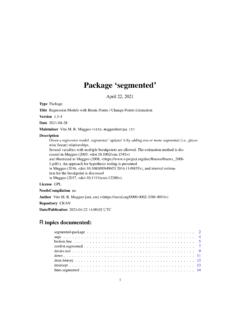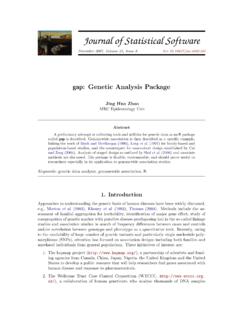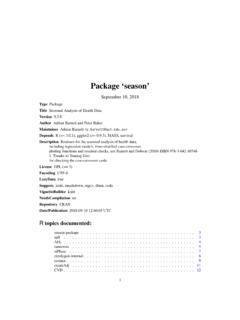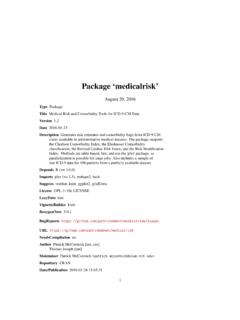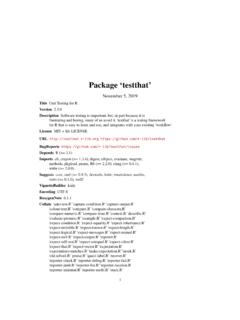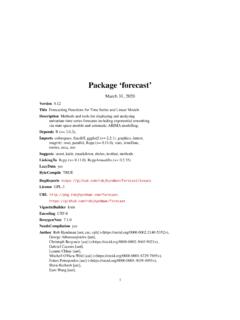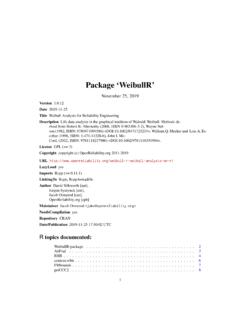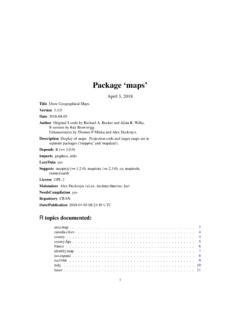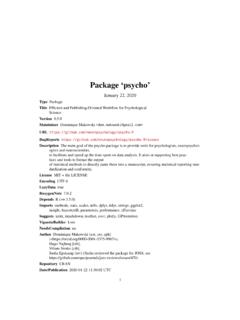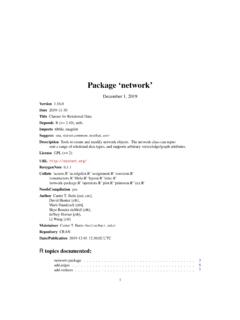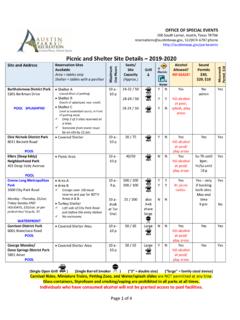Transcription of Package ‘emma’ - R
1 Package emma February 19, 2015 TypePackageTitleEvolutionary model-based multiresponse Kate Rob J (>= ), earth, clusterSimImportsmethodsDescriptionThe evolutionary model-based multiresponse approach (EMMA)is a novel methodology to process optimisation and productimprovement. The approach is suitable to contexts in which theexperimental cost and/or time limit the number of (>= 2)LazyLoadyesRepositoryCRANDate/Publicat ion2011-10-26 17:59:36 NeedsCompilationnoRtopics documented:emma- Package ..2ackley ..3distance ..4emma ..5emmacheck ..9emmat0 .. 12emmatn .. 14peaks .. 2012emma-packageIndex21emma-packageDesig ning experiments for process optimizationDescriptionThe evolutionary model-based multiresponse approach (EMMA) is a procedure for process opti-mization and product improvement.
2 It is particularly suited to processes featuring irregular exper-imental region due to constraints on the input variables (factors), multiple responses not accomo-dated by polynomial models, and expensive or time-consuming experiments. EMMA iterativellyselects new experimental points that increasingly concentrate on the most promising regions of theexperimental space. The selection of the new experimental points is performed on the basis of theresults achieved during previous trials. A multivariate adaptive regression splines (MARS) modeland a particle swarm optimization (PSO) algorithm are used to drive the search of the :emmaType: :2011-02-22 License:GPL (>=2)LazyLoad:yesAuthor(s)Laura Villanova, Kate Smith-Miles and Rob J HyndmanMaintainer: Laura Villanova L.
3 , Falcaro P., Carta D., Poli I., Hyndman R., Smith-Miles K. (2010) Functionalization ofMicroarray Devices: Process Optimization Using a Multiobjective PSO and Multiresponse MARSM odelling , IEEE CEC 2010, DOI: D., Villanova L., Costacurta S., Patelli A., Poli I., Vezzu S., Scopece P., Lisi F., Smith-MilesK., Hyndman R. J., Hill A. J., Falcaro P. (2011) Method for Optimizing Coating Properties Basedon an Evolutionary Algorithm Approach , Analytical Chemistry 83 (16), <- c("x1","x2")nlev <- c(20, 20)ackley3lower <- c(-3, -3)upper <- c(3, 3) <- "y"weight <- 1C <- <- c( , , , rep( , C-3)) <-emma( , nlev, lower, upper, , opt = "mx", nd = 10,na = 5, weight, C , w1 = , w2 = , c1i = , c1f = ,c2i = , c2f = , b = 5, , graph = "no", fn1 = peaks)plot( , fn = peaks, n = 50, C = 20)ackleyAckley test problemDescriptionGenerates the Ackley benchmark function.
4 The Ackley function is a commonly used test problemfor global optimization (x)ArgumentsxA matrix containing the values of the input of the same length asxgiving the values of the Ackley (s)Laura Villanova, Kate Smith-Miles and Rob J <- seq(-2, 2, length = 50)x2 <- x1x <- (x1, x2)z <- matrix(ackley(x),nrow = length(x1))nrz <- nrow(z)ncz <- ncol(z) <- colorRampPalette( c("red", "yellow") )nbcol <- 100color <- (nbcol)zfacet <- z[-1, -1] + z[-1, -ncz] + z[-nrz, -1] + z[-nrz, -ncz]facetcol <- cut(zfacet, nbcol)persp(x1, x2, z, col = color[facetcol], theta = 0, phi = 10,expand = 1, xlab = "x1", ylab = "x2", zlab = "f(x1, x2)",ticktype = "detailed")distanceDistance measure from the targetDescriptionComputes a scalar distance between the target (a set of desirable values for the responses) and theresponses values that have been either observed or estimated for each point in the experimentalspace.
5 Such a distance is used to identify additional experimental points to be (xpop, xspace, yspace, weight, opt)ArgumentsxpopA data frame containing the factor values for the experimental points investi-gated; the row names uniquely identify each experimental point (ID).xspaceA data frame containing the factor values for the experimental points definingthe entire experimental region; the row names uniquely identify each experi-mental point (ID).yspaceA data frame containing the response values (either observed or estimated) forthe points in the experimental numerical vector, of the same length as the number of responses, containingthe weights assigned to the each response; the sum of the weights must be equalto character vector, of the same length as the number of responses, defining ifeach response needs to be minimized or maximized.
6 The allowed values are mn (minimize) and mx (maximize).emma5 DetailsThe function normalizes the response values with respect to the estimated limits of the responsespace, so that the response values lie between 0 and 1. Subsequently, the function identifies thetarget and computes a scalar distance between the target and the response scalar distances between the target and the response(s) values for the exper-imental points distance from the target for the best experimental point identified (s)Laura Villanova, Kate Smith-Miles and Rob J HyndmanReferencesFriedman J. H. (1991) Multivariate adaptive regression splines (with discussion), The Annals ofStatistics 19, 1 L.
7 , Falcaro P., Carta D., Poli I., Hyndman R., Smith-Miles K. (2010) Functionalization ofMicroarray Devices: Process Optimization Using a Multiobjective PSO and Multiresponse MARSM odelling , IEEE CEC 2010, DOI: Model-based Multiresponse ApproachDescriptionEMMA designs the experiments using a procedure based on the Particle Swarm Optimization (PSO)algorithm. Firstly, EMMA selects a set of initial experimental points (seeemmat0) that define theinitial position of the particles; subsequently, for a given number of iterations, the particles aremoved and new experimental points are selected (seeemmatn).Usageemma( , nlev, lower, upper, , opt="mn", nd=10, na=5,weight, C = 20, w1 = , w2 = , c1i = , c1f = ,c2i = , c2f = , b = 5, , graph, fn1 = NULL,fn2 = NULL, fn3 = NULL, fn4 = NULL, nresp) vector containing the names of the input variables (factors).
8 NlevA numeric vector of the same length , containing the number offactor numeric vector of the same length , containing the lower values ofthe numeric vector of the same length , containing the upper values ofthe vector containing the name(s) of the output/response variable(s).optA character vector of the same length as the number of responses, indicating foreach response function, if the response must be minimized ( mn ) or maximized( mx ).ndNumber of experimental points to be selected whent = numeric value indicating the number of experimental points to be selectedwhent > numerical vector of the same length as the number of responses, reflecting therelevance of each response.
9 Useweight = 1if only one response is investigated;if multiple responses are investigated, the sum of the values inweightmust numeric value indicating the maximum number of first numeric value used to calculate the inertia weight parameter of the timevariant PSO algorithm; the default isw1 = second numeric value used to calculate the inertia weight parameter of thetime variant PSO algorithm; The default isw2 = first numeric value used to calculate the acceleration coefficientc1of thetime variant PSO algorithm; the default isc1i = second numeric value used to calculate the acceleration coefficientc1of thetime variant PSO algorithm; the default isc1f = first numeric value used to calculate the acceleration coefficientc2of thetime variant PSO algorithm; the default isc2i = second numeric value used to calculate the acceleration coefficientc2of thetime variant PSO algorithm; the default isc2f = numeric value, used in the mutation operator, that determines the degree ofdependence of the mutation on the iteration number.
10 The default isb = numeric vector of the same length as the number of iterationsCcontaining theprobability of mutation for each time ; if yes , a plot of the MARS model is produced. A plot is producedonly if the model contains more than one explanatory first function to be optimised. Usefn1 = NULLif the function is unknown( when designing experiments in applied problems).fn2 The second function to be optimised. Usefn2 = NULLif the function is un-known ( when designing experiments in applied problems).emma7fn3 The third function to be optimised. Usefn3 = NULLif the function is unknown( when designing experiments in applied problems).
